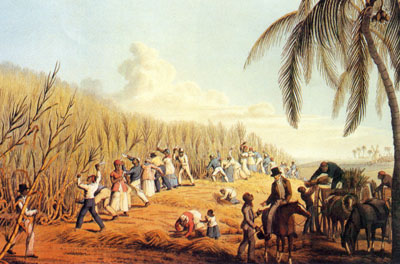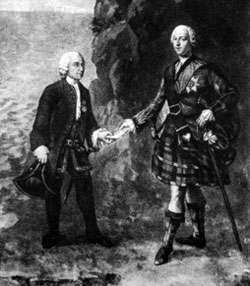|
In the
early eighteenth century, families from Connacht and
Munster, Archdeacons, Kellys, and Bourkes, established a
tradition of Irishmen holding the Jamaica’s highest legal
offices. Coming from a Catholic background, to achieve
these positions they had to conform to the established
church, but Protestantism in the Caribbean was always less
severely demanding than in the mainland colonies. Legal
office opened the way to the easy acquisition of land for
plantations so that all these families emerged as rich
slave owners. In 1752 the heiress Elizabeth Kelly,
daughter of Denis Kelly of Lisaduff, County Galway and
Chief Justice of Jamaica, married into the Brownes of
Westport, County Mayo, thus aiding their rise to Viscounts of Altamont
and Earls of Sligo. Irish names on the island continued to
mount among the substantial planter class, O’Hara,
O’Conner, Talbot, Coulthurst, Herbert, Gregory, Martin,
Madden, Forde, Richards, Dobbs, and de la Touche.
In the
mid-eighteenth century, the Ulster Presbyterians, famous
for settling as Scots-Irish in Pennsylvania and the
Appalachians, also appeared in the Caribbean. Some were
wealthy merchants who invested in plantations, Delapps
from Donegal and Dublin in Antigua and Jamaica and, from
Belfast, Blacks in Grenada, and Gregs and Cunninghams on
Dominica. Others worked as overseers or as commission
agents, selling Irish linen and provisions, expanding into
slaves, hoping that their fortunes would eventually rival
those they had formerly served.
The most
striking case here was that of the Blair brothers from
Newry. In the late eighteenth century James and Lambert
Blair left Newry to set up an agency on Saint Eustatia.
Their 1790 accounts reveal that the largest items of
purchase for their planter clients were slaves for a Mr.
Stevenson (Blair 1793:24). By the turn of the century when
the British took Demerara from the Dutch, the Blairs had
amassed enough capital to invest in the rich, wet, black
soiled lands of the new colony. After emancipation, when
the government paid out £20 million in compensation to the
plantation owners for the loss of their slaves, James
Blair junior received about £83,530 for his 1,598 slaves.
As such, he received more money than any other slave
holder in the British Empire (Higman 1967: 12).
In the
eastern Caribbean, Queely Shiell vindicated Montserrat’s
reputation as an Irish island by claiming for 920 slaves,
a number far in excess of anything the island’s largest
planters in previous times (the seventeenth-century Dutch
Waads and the eighteenth-century English Wykes) had ever
amassed. Indeed this claim meant that tiny Montserrat
produced the largest single compensation package in the
Leewards (Sessional 1837/: Montserrat).
|

Slaves cutting
cane on a plantation established by the Delapps of
Donegal,
from Ten Views of the Island of Antigua by
William Clarke, 1813
(The British Library) |
However,
the majority of those claiming and collecting under this
compensation scheme were small property owners possessing
ten slaves or less. Defenders of slavery complained that
its abolition would hit the most vulnerable hardest. Men,
drawing up wills, preferred to bequeath land to their sons
and moveable property (slaves) to female dependants. Thus,
widows and spinsters were often left with few resources,
save the ownership of slaves, who served them and could be
rented out to bring in an income. Irish names supply
evidence of this point. Examples from two parishes in
Jamaica show Brigit Garvey received compensation for eight
slaves; Elizabeth Anne Carroll seven; Jane Welch,
Elizabeth Geoghegan, Anne O’Meally, and Eleanor Tierney
six each; Elizabeth Anne Sherlocke, Elizabeth Slevin, and
Mary O’Sullivan five; Rebecca Fergus, Elizabeth Burke,
Cecelia Jane Murphy, Mary Anne Connolly four; Ann Rattigan
three; Mary Anne B. Hennessey, two; Jane Boyle, Brigit
Dillon, Mary Curtin one (Ibid: Jamaica). Again, the lists
of names on Montserrat and Antigua reveal examples of a
similar situation.
Throughout
the British West Indies, records for the eighteen thirties
attest to the tenacity of Hiberno-Caribbean connections.
In 1833 the Earl of Sligo (direct descendant of Elizabeth
Kelly and John Browne) claimed for 286 slaves and received
about £5,526 in compensation. In 1834 he was appointed
Governor of Jamaica with Dowell O’Reilly from County Louth
serving as his Attorney General. O’Reilly’s appointment
reiterated the Irish legal presence on the island. Unlike
his predecessors, the passing of Catholic emancipation in
1829 meant that he could take up his judicial appointment
as a Catholic.
Island-Hopping in the Caribbean
The Irish
had nonetheless never limited their Caribbean destinations
to British colonies. In the early 1670s a visitor came
upon a settlement of one to two hundred Irish on
Guadeloupe living ‘much as they do at home in little huts,
planting potatoes and tobacco, and as much indigo as will
buy them canvas and brandy and never advance so far as
sugar planting’(Cullen 1994:127). This group may not have
made such social progress but certainly next-door on
Martinique there were families who had done so. Kirwans,
Roches, Lynchs and Skerrets sought ennoblement from the
French Crown in the eighteenth century, claiming to have
left Ireland for the colony in the seventeenth century.
Social absorption for Irish Catholics in French and
Spanish colonies was relatively easy. In the late
seventeenth century, John Stapleton and his wife Helen
Skerret left Ireland for the newest and largest French
colony, Saint Domingue, where their success as planters
enabled them to move to France, buying a property in
Nantes (Holohan 1989: 29).
To make
this journey in reverse became more common as the Irish
merchant community on the Atlantic coast found itself at
the centre of France’s slave trade and sugar imports. In
the second generation, Galway Butlers, now in La Rochelle,
sent two sons to Saint Domingue where they established
extensive plantations (Ibid.: 97-100).
The most
famous Irish merchant family to use wealth gained in
France to establish plantations in Saint Domingue were the
Walshes. Antoine Walsh worked as a slave trader from 1730
to 1753, during which period his ships carried some 12,000
slaves across the Atlantic. In 1753 he retired from that
trade and left to settle on the family plantations on
Saint Domingue, where died in 1763 (Rodgers 2007:
106-112). His immediate heirs remained in the southern
province of that colony, among other grand blancs,
successful Hiberno-French planters, Sheil, O’Gorman,
Rourke, Macnamara and Plunket (Van Brock 1977, 13:89-104).
Back in
France, money from the slave trade and plantations helped
to fund the Irish college in Nantes and Walsh’s regiment
in the Irish brigade, which received its name from
Antoine’s nephew, coming from a new generation determined
to put trade behind them. Despite enormous losses in both
areas during the upheavals of the Revolution, these
families survive today in France as titled and
chateaux-owning.
|

Antoine Walsh and Bonnie Prince Charlie in Scotland,
from the picture hanging today in the library of the
Chateau of Serrant. Wealth gained in the slave trade
made it possible for Walsh to supply Charles Edward
Stuart with the shipping which conveyed him from
France to Scotland.
(Thomas 1997:192-193)
|
In
eighteenth-century Saint Domingue, Stapletons, Butlers and
Walshes were grand blancs. Yet Saint Domingue’s swiftly
expanding plantation economy, which made France the
greatest sugar producer in the Caribbean, offered
opportunities to men of modest means as well as to
wealthier investors, thus creating a class of petit blancs
engaged in small holding, overseeing, trade and artisan
activities, and all employing slave labour. Given the
existence of a substantial Irish presence in the Atlantic
ports (at once long established but also continuing to
receive young, impecunious arrivals from home) the
development of a group of Irish petit blancs is a likely
but as yet an un-researched topic in Irish-Caribbean
studies.
Irish
Mariners in the Antillean Sea
Irish
sailors constitute another historically neglected group
with significant Caribbean ties. We know that in the
closing years of the eighteenth century some twelve
percent of the crew on Liverpool slave ships were Irish (Behrendt
2005). Sailors making the direct voyage from home to the
Caribbean must also have been numerous. From the
seventeenth century onwards, the Munster ports achieved
international importance as the final point for taking on
water and victuals before the Atlantic crossing. Since the
West Indian islands furnished little in the way of
material for naval repairs, eighteenth-century Cork was
organised to produce sailcloth and rigging as well as
provision for British, French, Dutch, Danes and Bremeners
setting out on the Atlantic crossing.
Captains,
unexpectedly short on crew, must also have used Munster as
a point of last resort. Scattered evidence of Irish people
sailing the Caribbean suggests a wide social spectrum. The
County Kerry poet Eoghan Rua Ó Súilleabháin (1748-84)
wrote his only work in English in Port Royal, Jamaica. His
encomiastic poem to Admiral Rodney was perhaps embarked
upon in the hopes of gaining his discharge from the
British naval vessel on which he was a rating. Of the
pirate fraternity, Anne Bonny from Cork was sentenced to
death in 1720. Disguised in male clothing, according to
Daniel Defoe, she was ‘as forward and courageous’ as any
of her calling. Unlike her male colleagues, she was
reprieved from hanging on the grounds of her pregnancy (Applby
1991: 64).
Irish
Inter-Racial Marriages and Affairs
In 1775, nineteen-year-old Charles
Fitzgerald, naval officer, brother to Lord Edward
Fitzgerald, and third son of Emily, Duchess of Leinster,
wrote to his mother with literary panache that ‘the jet
black ladies of Africa’s burning sands have made me forget
the unripened beauties of the north’. A few months later
he followed this up with the news that she could look
forward to ‘a copper coloured grandchild’ (Tillyard
1995:331).
|


